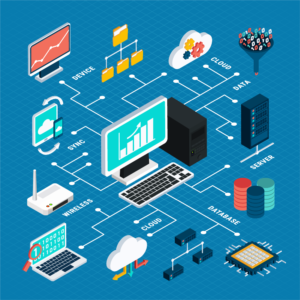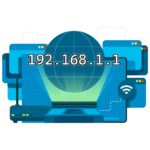Introduction to Networking
In today’s digital age, networking is the backbone of communication and data exchange. Whether you’re browsing the web, sending an email, or streaming a movie, networks are at work behind the scenes. But what exactly is networking, and why is it so important? This blog post will introduce you to the basics of networking, helping you understand the key concepts and components that make networks function.

What is Networking?
Networking refers to the practice of connecting computers and other devices to share resources and information. A network is a collection of interconnected devices (such as computers, servers, printers, and more) that communicate with each other to exchange data.
Key Components of a Network
Networks are made up of several essential components that work together to facilitate communication:
- Nodes:
- Nodes are the devices connected to a network, such as computers, printers, and servers. Each node has a unique address that identifies it on the network.
- Transmission Media:
- This is the medium through which data travels between nodes. It can be wired (e.g., Ethernet cables, fiber optics) or wireless (e.g., Wi-Fi, Bluetooth).
- Network Interface Card (NIC):
- A NIC is a hardware component that allows a device to connect to a network. It converts data into a format suitable for transmission over the network.
- Switches:
- Switches are devices that connect multiple nodes within a network, allowing them to communicate with each other by forwarding data to the correct destination.
- Routers:
- Routers are devices that connect different networks and direct data packets between them, ensuring that the information reaches its intended destination.
- Protocols:
- Protocols are standardized rules that govern how data is transmitted and received across a network. Common protocols include TCP/IP, HTTP, and FTP.
Types of Networks
Networks can be categorized based on their size, geographical scope, and the way they are managed. Here are some of the most common types:
- Local Area Network (LAN):
- A LAN is a network that covers a small geographical area, such as a home, office, or building. It typically connects a few devices and offers high-speed data transfer.
- Wide Area Network (WAN):
- A WAN spans a large geographical area, often connecting multiple LANs. The Internet is the largest WAN, connecting millions of networks worldwide.
- Metropolitan Area Network (MAN):
- A MAN covers a city or a large campus. It is larger than a LAN but smaller than a WAN, providing high-speed connectivity across a metropolitan area.
- Personal Area Network (PAN):
- A PAN is a small network that connects personal devices, such as smartphones, laptops, and tablets, within a range of a few meters.
- Wireless Local Area Network (WLAN):
- A WLAN is similar to a LAN but uses wireless technology (Wi-Fi) to connect devices within a limited area, such as a home or office.
How Do Networks Work?
Networks operate through a combination of hardware, software, and protocols that work together to transfer data between devices. Here’s a simplified overview of how data travels across a network:
- Data Transmission:
- When you send data (like an email or a file), your device breaks it down into smaller units called packets. These packets are then transmitted over the network to the destination device.
- Routing:
- Routers direct the data packets through the most efficient path in the network, ensuring they reach their intended destination. If the data is traveling over the Internet, it may pass through multiple routers along the way.
- Data Reception:
- The receiving device reassembles the data packets into their original form and processes the information. If any packets are lost or damaged during transmission, protocols like TCP/IP request retransmission to ensure accuracy.
Importance of Networking
Networking is crucial in today’s interconnected world. It enables:
- Communication: Networks facilitate communication between individuals and organizations, making it possible to send emails, make video calls, and share files in real-time.
- Resource Sharing: Networks allow multiple devices to share resources, such as printers, storage devices, and internet connections, reducing costs and increasing efficiency.
- Data Management: Networks help manage and store vast amounts of data, ensuring that information is accessible to authorized users whenever needed.
- Collaboration: Networking enables teams to collaborate remotely, working on shared projects and accessing common data repositories regardless of their physical location.
Conclusion
Understanding the basics of networking is essential for anyone looking to navigate the digital world confidently. From the key components of a network to the different types and how they work, this introduction provides a solid foundation for further exploration into more advanced networking concepts.
At computerclimax.com, we are dedicated to helping you stay informed about the latest in networking and communication technologies. Stay tuned for more in-depth articles and guides to help you build, manage, and secure your networks.
More to Explore
- Learn more about the essential network protocols that form the backbone of networking.
- Discover step-by-step instructions on how to set up a secure Wi-Fi network in your home.
- Learn the future of computer networking from CompTIA’s trusted educational resources.
Related
Discover more from Computer Climax
Subscribe to get the latest posts sent to your email.






One Response